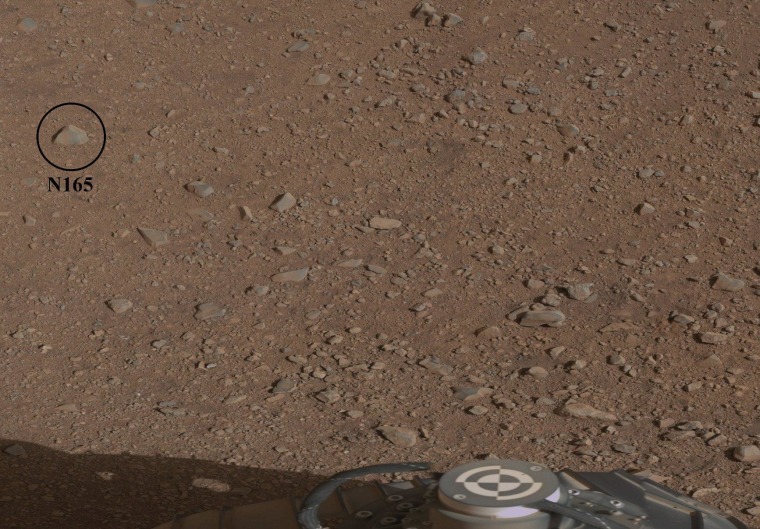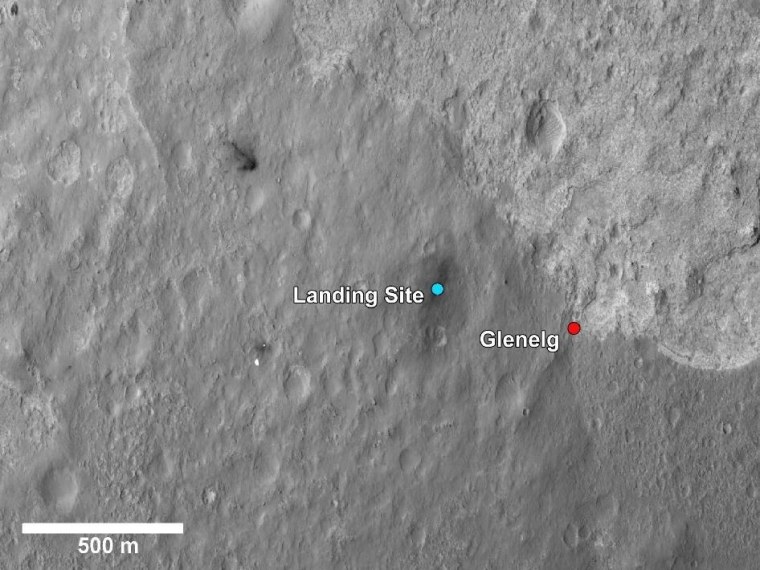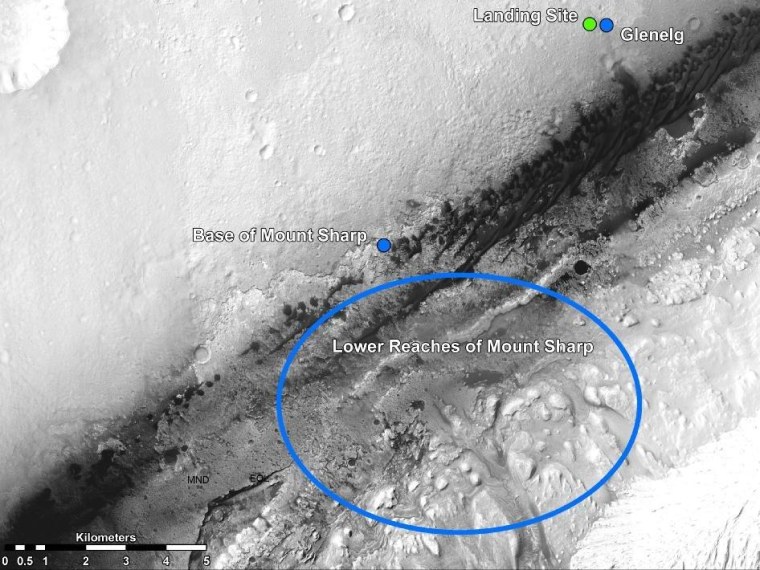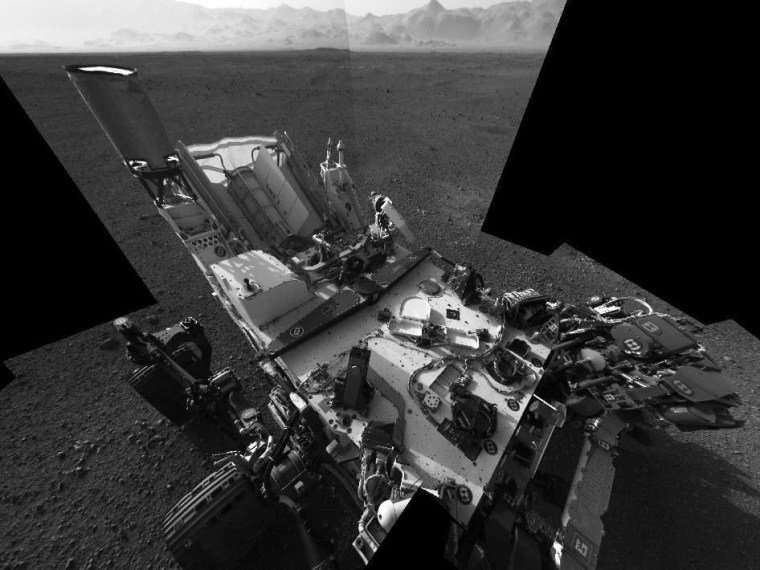NASA's Curiosity rover hasn't rolled its wheels on Mars yet, but scientists have already figured out what the rover will be doing and where it'll be going through the end of the year.
On Saturday night, Curiosity is due to use its laser blaster for the first time, taking 30 shots at a poor little rock known as N165. In the coming days, the rover also will analyze the rocks that have been exposed at a blast mark known as Goulburn Scour, which was left behind by Curiosity's rocket-powered sky-crane descent stage during the Aug. 5 landing. And it will take its first test drive, going about 10 feet (3 meters) to limber up for its first long-distance journey.
Over the course of a month or two, the six-wheeled, nuclear-powered rover will make a trek to a spot that's been nicknamed Glenelg, about a quarter-mile (400 meters) east of the landing site, project scientist John Grotzinger told reporters during a teleconference today.
"With such a great landing spot in Gale Crater, we literally had every degree of the compass to choose from for our first drive," Grotzinger explained in a news release. "We had a bunch of strong contenders. It is the kind of dilemma planetary scientists dream of, but you can only go one place for the first drilling for a rock sample on Mars. That first drilling will be a huge moment in the history of Mars exploration."
Glenelg is the spot where three types of geological formations come together. Heading to Glenelg means the rover will have to retrace its route to move on to its prime target, a 3-mile-high (5-kilometer-high) mountain known as Aeolis Mons or Mount Sharp. But Grotzinger and his colleagues think the scientific payoff will be worth it.
Grotzinger told reporters that Glenelg, a Gaelic-derived place name that describes a rock formation in northern Canada, was particularly apt for the Martian site because it's a palindrome, spelled the same way forward and backward. Similarly, Curiosity will have to double back toward its landing site after visiting Glenelg on Mars. "We get it coming and going," he said.
After Glenelg, Curiosity will head toward Mount Sharp. It could be the end of the calendar year before the mountain trek begins in earnest, and Grotzinger has previously estimated that getting to Curiosity's first major target amid the mesas and buttes at the base of Mount Sharp might require a full Earth year. Curiosity's $2.5 billion primary mission is due to last almost two Earth years, or one complete year on Mars. However, most team members expect the rover to last far longer.

'Target practice' for laser zapper
The mission's purpose is to analyze Martian rock and soil to determine whether the planet's chemistry could have supported life in Mars' ancient past, when the planet was wetter and warmer than it is today. The car-sized, 1-ton Curiosity rover has 10 scientific instruments to do the job — including its ChemCam imaging system, which incorporates a laser powerful enough to vaporize tiny spots of rock.
N165, a 3-inch-wide (7.5-centimeter-wide) rock sitting on the ground about 10 feet (3 meters) from the rover, would be the first target for the laser zapper, said Roger Wiens, a planetary scientist from Los Alamos National Laboratory who is the ChemCam team's prinicipal investigator. About 30 laser blasts would be aimed at the rock over the course of 10 seconds.
"This is sort of target practice, if you will," Wiens said.
Each 14-millijoule laser pulse briefly focuses the energy equivalent of a million light bulbs onto an area the size of a pinhead. The flashes of light given off by the mini-blasts of plasma are captured by ChemCam's imaging system and routed through fiber optics to a spectrometer inside the rover. By checking the spectrum of the light, scientists can figure out the composition of the material vaporized by each zap.
Wiens said he expected N165 to be the kind of garden-variety basalt rock typically found on Mars. He and his colleagues are more interested in finding out whether ChemCam can discriminate between the rock's dusty coating and the minerals beneath the coating. That's why the rock is being blasted so many times in succession. The first results could be revealed early next week, Wiens said.
"Our team has waited eight long years to get to this date," Wiens said.
Instruments coming to life
Grotzinger said the checkouts for all of Curiosity's scientific instruments are going well. Just today, the neutron-generating device known as DAN (Dynamic Albedo of Neutrons) was turned on while another instrument called RAD (Radiation Assessment Detector) monitored the radiation that DAN was giving off, he said.
The rover's weather station, dubbed REMS (Rover Environmental Monitoring Station), is already providing temperature readings: Grotzinger said the high temperature on Mars over the past day was just above freezing (276 Kelvin, which is 37 degrees Fahrenheit or 2.85 degrees Celsius).
"It's been exactly 30 years since the last long-duration-monitoring weather station was present on Mars," he said. "That was when the Viking 1 lander stopped communicating with the earth. That was back in 1982, so 30 years later we're happy to be on the surface doing that monitoring again."
The instrument checkout should be complete "toward the end of next week," Grotzinger said. At one time, he had suggested that the blast marks left behind by the descent stage, just yards away from the rover's landing site, might be a good first target for detailed sampling. But today, Grotzinger said that the exposed bedrock at Goulburn Scour appeared to be a loosely held-together combination of material. "This rock is really not a good one for the first drilling," he said.
So instead, scientists will examine the blast marks with Curiosity's cameras, perhaps including ChemCam, and then most likely move on. The blast marks have been given names that reflect their fiery genesis: Goulburn, Burnside, Hepburn and Sleepy Dragon. "The theme here is heat," Grotzinger said.
The first samples could well be scooped from the Martian surface at some point between the landing site, which is in a quadrant that's been nicknamed Yellowknife, and the Glenelg site, Grotzinger said. Those samples could be ground up and deposited into a couple of onboard chemical laboratories called CheMin and SAM (which stand for "Chemistry and Mineralogy" and "Surface Analysis at Mars," respectively). "That first scooping activity is really important," Grotzinger said.


The soil sampling efforts should provide the confidence needed to go ahead with the first rock drilling operation at Glenelg, he said. Once the rover arrives at Glenelg, it's likely to spend at least a month studying the intriguing variations in the site's geology, which could shed light on the changes that shaped 96-mile-wide Gale Crater over the course of eons, Grotzinger said.
"Sometime toward the end of the calendar year ... I would guess then we would turn our sights to the trek toward Mount Sharp," he said.
Mount Sharp is considered prime territory for Curiosity's scientific prospecting because its layers of rock are thought to record billions of years' worth of geological history. Detailed analysis of the rock chemistry could reveal what happened to Mars between the warm, wet environment that's thought to have existed long ago and the cold, dry environment that exists today.
More about Mars:
- Rover reveals more of Martian peak
- Mars rover team faces the masses
- Mars fans make viral video
- Panoramas add spin to Mars
- Mars rover survives its 'brain transplant'
- Mars orbiter gets a long look at Curiosity rover
- Reprogrammed rover getting ready to roll
- Obama tells rover team: Watch out for Martians
- Search for life to shape future Mars missions
- Mars rover getting reprogrammed for science
- Why the rover has such a dinky camera and computer
- How to build your own Mars rover with Lego blocks
- The Puff on Mars: Photo mystery solved!
- Panorama reveals a colorful Mars
- NBC video: Panorama featured on 'Nightly News'
- Curiosity reveals a Martian Mojave
- Tour the Martian Mojave in 3-D
- Flying saucer spotted over Mars
- First 3-D pictures sent by Curiosity
- Orbital photo spots rover and its trash
- Curiosity sends color snapshot from Mars
- Rover video looks down on Mars during landing
- Mars orbiter spots rover in midair
- NASA's Mohawk Guy marvels at his fame
- Curiosity rover scores touchdown on Mars
Alan Boyle is NBCNews.com's science editor. Connect with the Cosmic Log community by "liking" the log's Facebook page, following @b0yle on Twitter and adding the Cosmic Log page to your Google+ presence. To keep up with Cosmic Log as well as NBCNews.com's other stories about science and space, sign up for the Tech & Science newsletter, delivered to your email in-box every weekday. You can also check out "The Case for Pluto," my book about the controversial dwarf planet and the search for new worlds.
